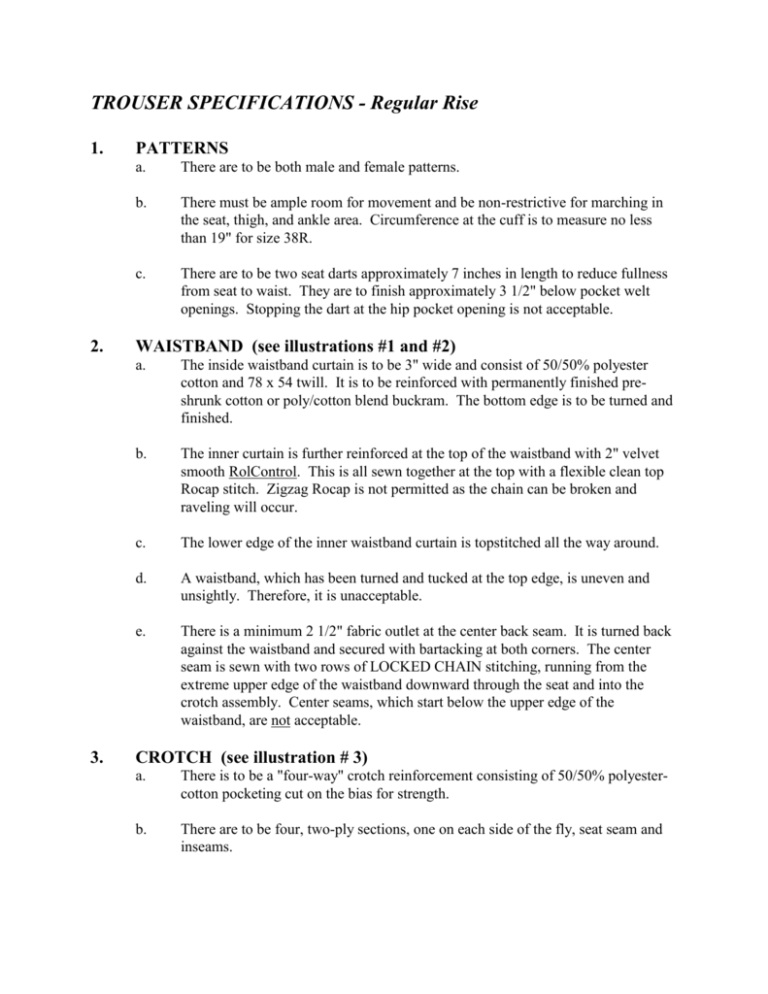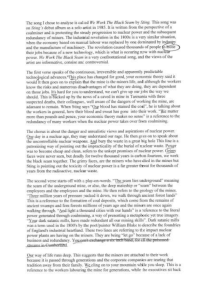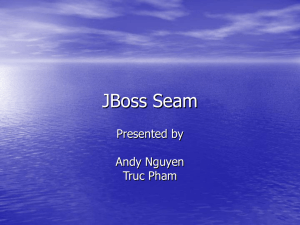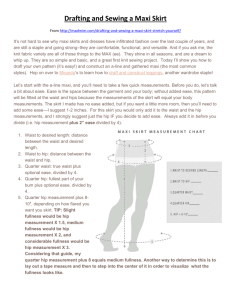Illustration #2
advertisement

TROUSER SPECIFICATIONS - Regular Rise 1. 2. 3. PATTERNS a. There are to be both male and female patterns. b. There must be ample room for movement and be non-restrictive for marching in the seat, thigh, and ankle area. Circumference at the cuff is to measure no less than 19" for size 38R. c. There are to be two seat darts approximately 7 inches in length to reduce fullness from seat to waist. They are to finish approximately 3 1/2" below pocket welt openings. Stopping the dart at the hip pocket opening is not acceptable. WAISTBAND (see illustrations #1 and #2) a. The inside waistband curtain is to be 3" wide and consist of 50/50% polyester cotton and 78 x 54 twill. It is to be reinforced with permanently finished preshrunk cotton or poly/cotton blend buckram. The bottom edge is to be turned and finished. b. The inner curtain is further reinforced at the top of the waistband with 2" velvet smooth RolControl. This is all sewn together at the top with a flexible clean top Rocap stitch. Zigzag Rocap is not permitted as the chain can be broken and raveling will occur. c. The lower edge of the inner waistband curtain is topstitched all the way around. d. A waistband, which has been turned and tucked at the top edge, is uneven and unsightly. Therefore, it is unacceptable. e. There is a minimum 2 1/2" fabric outlet at the center back seam. It is turned back against the waistband and secured with bartacking at both corners. The center seam is sewn with two rows of LOCKED CHAIN stitching, running from the extreme upper edge of the waistband downward through the seat and into the crotch assembly. Center seams, which start below the upper edge of the waistband, are not acceptable. CROTCH (see illustration # 3) a. There is to be a "four-way" crotch reinforcement consisting of 50/50% polyestercotton pocketing cut on the bias for strength. b. There are to be four, two-ply sections, one on each side of the fly, seat seam and inseams. 4. 5. c. Crotch area is to be clean finished with no extra fabric extending from tops of inseams. d. Trousers having merely a two-way reinforcement or no reinforcement at all, are not acceptable. FRONT CLOSURE a. The inside of the right fly will be lined with a layer of durable polyester cotton material. It is to extend beyond the four-way crotch assembly. b. The left fly is to be reinforced with Pellon SF134W to provide permanent shape retention and durability. It is to be bound with a preshrunk, bias cut, tape for appearance and durability. c. There is to be a permanent "two-piece" French fly, which buttons into the left front of the trouser. It is to be two-ply, stitched and turned. d. There are to be three bartacks at the base of the fly for additional reinforcement; two vertical bartacks on the lower front fly interior and one horizontal bartack at the bottom of the lower front fly exterior. e. The fly zipper is to be SOLID BRASS of Y.K.K. quality. There is to be a #3 hardened brass wire stop at the base of the zipper. The zipper teeth are to be removed at the top, with the zipper tape extending under the waistband tab. Zipper teeth extending up into waistband tab will weaken the seam and are not acceptable. f. The front fly is to be secured at the top of the waistband with two stainless gripper snaps placed above the zipper terminal. A double hook flex closure can also be used. It is to have a 3/4" Banrol reinforcement to prevent tearing at the point of closure. Banrol is to be stitched into the seam, not just spot-placed behind the hook and eye closure. ADJUSTA-BAND (see illustration #4) a. With "Adjusta-band", the top of the trouser waistband on the back part is to have three heavy duty Universal male gripper snaps spaced approximately 1" apart. On the forepart, there is to be one heavy duty Universal female gripper snap properly positioned at the upper portion of a 3/4" by 2" tunnel loop which is sewn to the inside of the waistband curtain. Passing through this tunnel loop is a 1" by 4" cloth loop made of the same fabric as the trousers, stitched down both at the front edge of the back part and out approximately 4" on the outside of the trouser top. The attached cloth loop is to slide through the tunnel loop and is to cover the three male snaps so they are not visible. This snap and loop arrangement is to be installed on both sides of the trouser top. The above described adjustment assures a generous adjustability and eliminates the need for the side zippers style adjustment. The lengths of the cloth loop will vary depending on trouser size, but the lengths given here are based on a 32" adjustable waist trouser size. b. The waistband is vertically split at each side seam and extra fabric added to facilitate the "adjustable" feature. The split edges are finished with the rear portion of the waistband securing underneath the forward portion. c. A gusset pleat is added at the opening by sewing additional fabric into the seam, both on the under portion and top portion of the waistband. All edges are neatly serged and a double row of lock stitches provides a durable construction. The pleat is to be fashioned in a "dog ear" shape to facilitate smoothness and strength. Trousers constructed without a pleat, or those with a flimsy "accordian" pleat, are not acceptable. 6. 7. POCKETS (see illustration #2) a. Pockets, when specified, are to always be built into the hip area or the front waistband and NOT just as an extension of the adjustable side flaps. b. Hip pockets are cut, sewn, turned and welted into the whipcord fabric by a Durkopp 745 double-piped lock-stitch machine. Chain stitched pocket welting is not acceptable. All openings are reinforced with Pellon and bartacked on each end with tacks on the inside so as not to be visible on the outside. c. Pockets are to be a pre-creased pocket with a sonic sealed edge to prevent any raveling on inside or outside of the pocket. d. FOB watch pockets, when specified, are to be the same pre-creased pocket and are to be bartacked at the two upper corners. e. Pocketing material is to be 70/30 poly/cotton, 50/50 in the warp and 100% poly in the fill. f. Pockets constructed in a "sandwiched" or "bag" fashion are unacceptable. BELT LOOPS a. There are to be eight belt loops, four on each side of the waistband, and they are to be secured with bartacks along the bottom of the waistband curtain. b. There is to be no belt loop centered over center back seam. This would interfere with alterations. c. Loops are to extend only to the bottom of the waistband, allowing use of a 2" wide belt. 8. 9. LEGS (see illustrations #5 and #6) a. Trouser legs are to be finished at the bottom with a 3" turn under to allow alteration for future growth. b. Legs are cut straight down from the knee, resulting in a circumference of 19" at the finished bottom edge. A flare cut trouser is available as an option and measures approximately 21" around the finished edge. (Dimensions as per 38R, and graded accordingly). c. The hem is to be taped all around with a pre-shrunk bias poly/cotton finishing tape, then blind stitched for appearance and ease of alterations. Taping all around provides a clean, finished edge for full-length use, as well as protecting the fabric edge completely. Simple flat taping with a rayon hem tape is unacceptable. d. Striping is centered over the outseam, and NOT sewn into the seam. It is to run the full length of the leg, including the turn-up allowance at the bottom edge. It is to be finished "flat" at the cuff turn under edge, not folded under the edge. e. The outseam of each trouser leg is to be a triple safety serged seam, or "blue jean" stitch. This type of seam is much stronger than the traditional "busted" seam, and adds strength and stability to the "stripe side" of the leg. Flat pressed or "busted" seams in this area are unacceptable. f. The inseam of each leg is to be a flat pressed or "busted" seam whereby both ends of the fabric are lock-stitched together and pressed back, flat. This is necessary to facilitate alteration of the trouser within the seat and upper thigh area and allows comfort in the inner crotch area. g. On request, an adjustable hem feature is available. The ridged/grooved polyester snap-tape shall extend from the bottom of the hem 12” with a total of 11 male snaps and 11 female snaps (22 total snaps) and will be centered on both inseam and outseam. This allows a ½” of adjustability with each snap for a total of 11” of adjustability. The snap tape will be back-tacked on each end with a 3/8 – 1/2” tack. Sideseams will be “clean SUSPENDER BUTTONS a. When specified, suspender buttons are to be 4 hole phenol or bone. There are to be four in the front and two in the rear. b. Suspender buttons are to be machine-sewn into the inner waistband curtain. c. Buttons are not to be sewn into the FOB pocket and must not interfere with the function of the adjustment gripper. 10. SERGING a. 11. 12. BARTACKING a. Lower front fly, Exterior - One (horizontal) crossing seat seam. b. Lower front fly, Interior - Two (vertical). c. On 1" fabric welt, holding the metal locking tab portion of the adjustable waistband feature; one each side - Two (vertical). d. Rear of each adjustable zipper, one each side - Two (vertical). e. Each corner of the hip pocket opening welt (to secure pocket corners on the inside of the pants), two per pocket - Four (not to be visible on outside of pants). f. Center back seam at upper edge on inside waistband - One (horizontal). g. Each edge of center seam "outlet", to the inside waistband - Two (horizontal). h. Lower and upper edge of each belt loop - Sixteen. There are still eight bartacks along the bottom of the waistband curtain when belt loops are not used. THREADS a. 13. All edges of seams and outlets are to be serged in a professional, high quality manner, eliminating the possibility of raveling. Threads for seaming are to be 50/3 cotton wrap core, 70/2 poly wrap core, or 100/2 poly wrap core, based on the strength requirements of the type of seams. PERMANENT SUSPENDERS a. Permanent suspenders are to be constructed of heavy-duty nylon “Bulk” webbing and are to be sewn in between waistband curtain and whipcord fabric, utilizing two vertical bartacks on each strap. b. Adjustable slider is to be one-piece molded indestructible polymer. c. Ends are to be neatly serged and stitched down with lock stitch. d. There is to be no elastic attached to suspenders, as it will not retain elasticity throughout the life of the garment. f. Use of "seatbelt webbing" or whipcord fabric is not acceptable, for lack of proper support and durability in this highly stressed area of the garment. Illustration #1 Illustration #2 Illustration #3 Illustration #4 Illustration #5 Illustration #6




